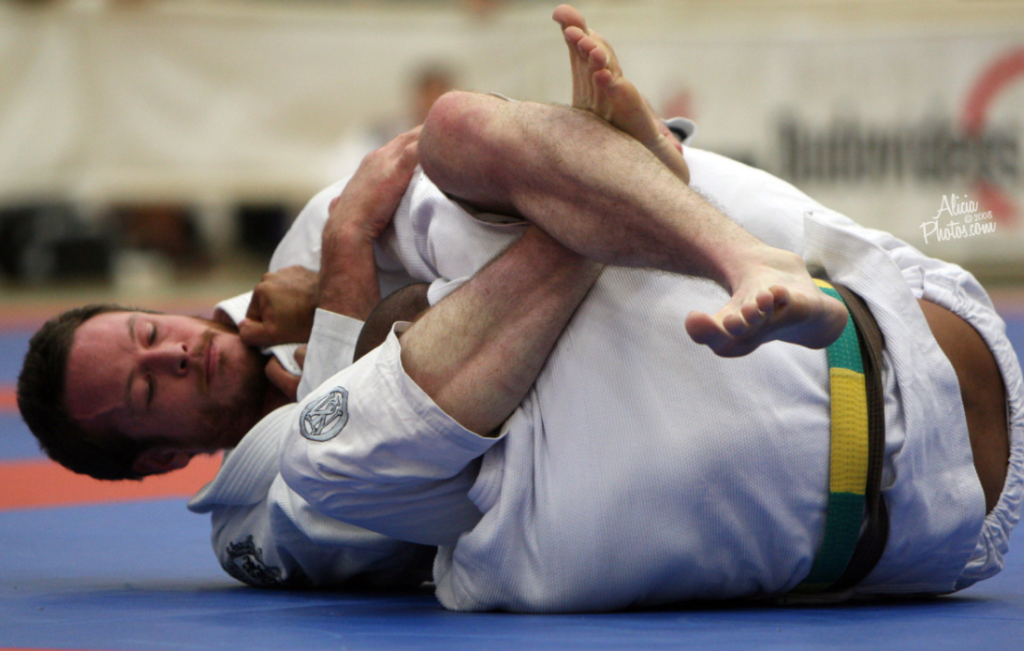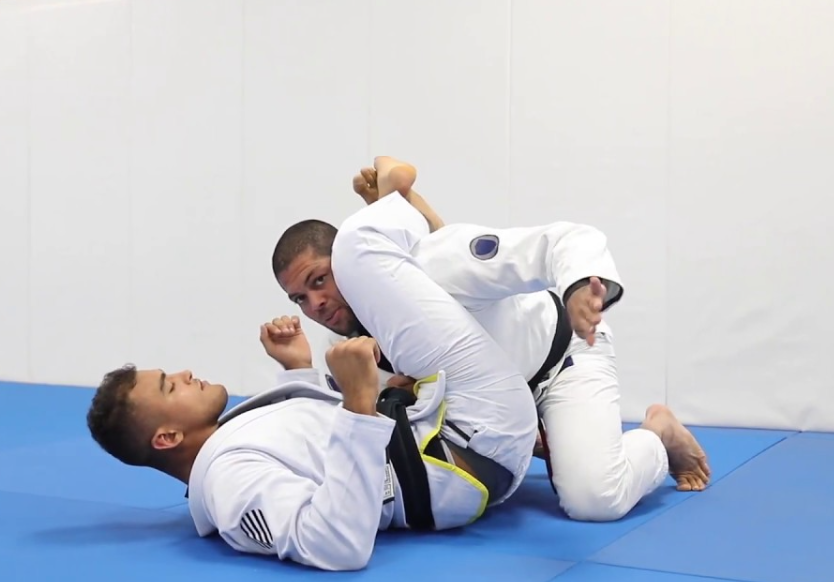
If you practice any grappling art, such as Brazilian Jiu-Jitsu, Judo, Mixed Martial Arts, or Submission Wrestling, you have probably encountered the triangle choke. The triangle choke is one of the most common and effective submissions in grappling, and it can be applied from various positions, such as the guard, the mount position, the side control, or even standing up.
However, being caught in a triangle choke does not mean that you have to give up or tap out. Learning how to escape a triangle choke is an essential skill for any grappler who wants to improve their defense, confidence, and survival skills.
In this article, we will show you how to escape a triangle choke using two approaches: the “traditional one” and a slightly unorthodox one that is bound to become your favorite triangled defense/guard pass combo.
By the end of this article, you will have a complete guide on how to escape a triangle choke from any situation.
Traditional Steps to Defend Triangle Chokes
The triangle choke has been around since the inception of BJJ, and people have developed effective ways of blocking, disrupting, or flat-out escaping it. The “traditional” principle-based approach works against all kinds of variations like the front triangle and side triangle setup, for example.
The answer to the question of how to escape a triangle choke does not have to stop at the traditional approach, though In fact, you don’t even have to see the triangle as something to escape, but rather as an opportunity for you to counterattack the bottom person, with something like a guard pass, for example.
But, before we go into advanced strategies like that, let’s see what the bread and butter methods of escaping a triangle choke are:
Stage 1: Prevent the Triangle Position
The first stage of escaping a triangle choke is prevention. This means that you want to avoid getting into a situation where your opponent can lock their legs around your neck and one arm in the first place.
This is easier said than done because there are many ways that your opponent can set up a triangle choke from different positions. Some of the common ways that your opponent can set up a triangle choke:
- closed guard,
- open guards,
- top and bottom side control,
- top mount,
- back control, and
- standing.
The versatility of triangle choke setups makes them efficient because they’re unpredictable and available. However, there are also some general tips that you can follow to prevent a triangle choke from happening:
- Maintain good posture: Keeping your head up and your back straight will make it harder for your opponent to pull your head down or push your arm across your body. It will also make it easier for you to see what they are doing and react accordingly.
- Keep your elbows close to your body: Keeping your elbows close to your body will prevent your opponent from isolating one of your arms and creating space for their legs. It will also protect your arms from other attacks, such as armbars or kimuras.
- Control your opponent’s hips and legs: Controlling your opponent’s hips and legs will limit their mobility and ability to create angles and space for their legs. You can use your hands, arms, knees, or feet to control their hips and legs, depending on the position. You can also use your body weight to pin them down and restrict their movement options.
- Be aware of your opponent’s movements: Being aware of your opponent’s movements will help you anticipate their attacks and defend accordingly. Stay alert not just to the obvious things but also to the placement of limbs key to triangle chokes. For example, if you avoid placing an arm in between the opponent’s legs, you do not have to worry about how to escape a triangle choke.
By following these tips, you will be able to prevent a triangle choke from happening in most cases. Still, sometimes your opponent will be faster, stronger, or more skilled than you, and they may manage to lock their legs around your neck and one arm.
In that case, you need to move on to the next stage of escaping a triangle choke: regaining posture.
Stage 2: Posture is Everything!
The second stage of escaping a triangle choke is posture. This means that you want to regain your posture as soon as possible before your opponent can tighten the choke.
If your opponent manages to lock their legs around your neck and one arm, they have already achieved a strong choking position. However, this does not mean that they have finished the choke yet.
There are still some factors that they need to adjust in order to complete the choke, such as:
- Pulling your head: Pulling your head down will increase the pressure on your neck and make it harder for you to breathe.
- Pushing your arm across your body: Pushing your arm across your body will cut off the blood flow to your brain with your own shoulder.
- Angling their hips out: Angling their hips out will tighten the triangle by reducing the space between their legs.
If your opponent manages to do all these things, they have achieved a full triangle choke, and you are in big trouble. You may only have a few seconds before you pass out or tap out. Therefore, you need to act fast and regain your posture before you can tighten the choke.
There are some common ways that your opponent can break your posture, such as:
- Pulling your torso down with their legs.
- Pulling your head down with their arms.
- Pushing your arm across your body with their legs/arms.
If your opponent manages to break your posture in any of these ways, you need to regain your posture as soon as possible.
This is how to escape a triangle choke in the mid-stage by focusing on your posture:
- Use smart frames: Framing off your opponent’s hips (or sometimes chest) will create some space between you and them and allow you to lift your head up. You can use your hands, arms, elbows, or forearms to create a frame against their hips or chest, depending on the position.
- Pushing their knee down: Pushing their knee down will open up their legs and reduce the pressure on your neck. This is (or was) known as the Roger Gracie defense. You can use your hand or arm to push their knee down, depending on the position, or use your head or shoulder.
- Stacking them up: Stacking will compress the opponent’s chest and make it harder for them to breathe. It will also make it harder for them to angle their hips out or pull your head down. You can use your body weight and momentum to stack them up by driving forward with your legs and shoulders.
Even if you do all of the above perfectly, some people will still manage to have a tight triangle choke sinched in. When you are in this particular predicament, you need to move on to the next (final) stage of defending a triangle choke: a very, very late escape.
Stage 3: Late Triangle Escapes
The third stage of escaping a triangle choke is late escape (a.k.a. a Hail Mary). This means that you want to use some specific techniques to escape the triangle choke before you pass out or tap out.
The finishing mechanics of a traingle choke are specific and if you are wondering how to escape a traingle choke that is fully locked in, you’ll need to reverse engineer the finishing mechanics in order to prevent the pressure from forcing you to submit:
- Squeezing the legs together: Squeezing their legs together will increase the pressure on your neck and make it harder for you to breathe. It will also prevent you from creating any space between their legs.
- Pulling the head down: Pulling your head down will increase the pressure on your neck and make it harder for you to breathe. It will also prevent you from lifting your head up and regaining your posture.
- Lifting the hips: Lifting their hips up will tighten the triangle by reducing the space between their legs. It will also align their legs with your carotid arteries and increase the effectiveness of the choke.
If your opponent manages to do all these things, they have finished the choke, and you are likely to pass out or tap out in seconds. Therefore, you need to act fast and use some specific techniques to escape the triangle choke before they can finish the choke.
Some specific techniques that you can use to escape a triangle choke include:
- Elbow down: The elbow down escape is a great go-to as soon as you realize your posture has been compromised. For starters, your opponent will have a much easier time choking you if your arm is across your body, thus cutting off your carotid artery with your own shoulder. If the elbow of your trapped arm is pointed out and downward, you will be considerably harder to choke.As soon as your opponent locks in the triangle, even if they have a figure four configuration with their legs, open your elbow out and bring your chest forward. Be sure to protect your arm (the arm that’s inside the triangle), as this is likely to be a secondary attack for your opponent. Slowly walk your shoulders and feet in the direction of your opponent’s ankles until they come open.Remember: even if the ankles don’t open up, you’re still surviving, likely for far longer than you otherwise might!
- Knee pin: The knee pin escape is a good option if you are caught in a super deep triangle, and not only does your opponent have the figure four with their legs, but they’ve also managed to get your arm across your body so that your own shoulder is completing the choke across your carotid artery.In this situation, you need to create some space between their legs and relieve some pressure on your neck. To do this, you can use your free arm to grab their knee and pin it to the ground. This will prevent them from squeezing their legs together or lifting their hips up.Then, you can use your head or shoulder to push their other leg down and create more space. Once there is enough space, you can slide your trapped arm out or your other arm back into the guard.
- Shoulder walk: The shoulder walk escape is a simple but effective way to escape a triangle choke by using your legs and shoulders to create distance and open up their legs.To do this, you need to place both of your hands on their hips and push them away from you. Then, you need to walk your shoulders back and away from them as well. This will create some space between you and them and make it harder for them to tighten the triangle.Once their legs come loose, you can slide your trapped arm out or your other arm back into the guard.
- Leg over: The leg over escape is a risky but rewarding way to escape a triangle choke by using your leg to break their grip and pass their guard.To do this, you need to lift your free leg over their head and hook it under their chin. Then, you need to pull the opponents head back with your leg and push their leg up with your arm. This will break their grip and open up their legs.Then, you can slide your trapped arm out and pass their guard to side control or mount.
These are some of the specific techniques that you can use to escape a triangle choke from different positions. They will work for different triangles universally, like an inverted triangle or rear triangle choke. Still, how to escape a triangle choke is an art, and you don’t have to stop at the escape.
How to Escape a Triangle Choke Using Wim Deputter’s King’s Gambit
Wim Deputter is a Brazilian Jiu-Jitsu black belt from Belgium who has competed more than 600 times in BJJ, grappling, and MMA. He is also a renowned instructor who has produced many instructional videos and courses on various aspects of grappling.
Wim Deputter uses the “King’s Gambit” approach to defend the triangle choke and takes it further to pass the guard with it. A gambit is a chess move where you sacrifice a piece in order to gain tactical, positional, or other advantage. In other words, Deputter deliberately gives up his arm or his posture in order to create an opening for his escape or his pass when his opponent goes for a triangle.
Wim Deputter’s gambit triangle defense is based on three main principles:
- Pushing the knee down with both hands: This technique is similar to the knee pin escape, but instead of using one hand to pin the knee down, Wim Deputter uses both hands to push the knee down with force.This creates a lot of space between his opponent’s legs and relieves a lot of pressure on his neck. It also exposes his opponent’s back or side for him to pass.
- Grabbing both ankles and lifting them up: This technique is similar to the shoulder walk escape, but instead of using his hands on his opponent’s hips, Wim Deputter uses his hands to grab both of his opponent’s ankles and lift them up.By doing this he creates a lot of space between him and his opponent and makes it harder for them to tighten the triangle. It also exposes their legs or hips for him to pass.
- Grabbing one ankle and driving forward: For this, Deputter uses his hand to grab one of his opponent’s ankles and drive forward. This breaks his opponent’s leg grip and opens up their legs. It also exposes their back or side for him to pass.
These are some of the gambit defense techniques that Wim Deputter uses to defend the triangle choke and use it to pass the guard. They are risky but rewarding, and they require a lot of practice and timing to execute.
Conclusion
In this article, we have shown you how to escape a triangle choke in the traditional way, using the three-stage method: prevention, posture, and escape.
We have also shown you some of the common mistakes to avoid when defending a triangle choke, and some of the best tips and techniques to escape a triangle choke from different positions.
Finally, we introduced you to some of the triangle defense concepts from Wim Deputter, more precisely, his gambit approach to defend the triangle choke and use it to pass the guard.
Learning how to escape a triangle choke is an essential skill for any grappler who wants to improve their defense, confidence, and survival skills. However, learning how to escape a triangle choke is not enough. You also need to practice these techniques regularly with a partner and seek feedback from your coach or instructor. Only then will you be able to master these techniques and apply them in real situations.
Amazing Flying Triangle At UFC Vegas 17 by BJJ Black Belt Jimmy Flick


![Darce Choke Encyclopedia – Origins, Mechanics and Variations [2025] BJJ, choke, Brabo, BJJ Darce Choke, D'arce Choke, Darce BJJ Choke](https://bjj-world.com/wp-content/uploads/2017/11/JungPoirierLeeYahoo-218x150.jpg)















![Jiu-Jitsu For Old Guys Guard Retention Bernardo Faria DVD Review [2025] Jiu-Jitsu For Old Guys Guard Retention Bernardo Faria DVD Review](https://bjj-world.com/wp-content/uploads/2025/03/old-guys-guard-retention-bernardo-faria-dvd-review-218x150.png)
![X-Guard Trickery Kyle Sleeman DVD Review [2025] X-Guard Trickery Kyle Sleeman DVD Review](https://bjj-world.com/wp-content/uploads/2025/03/x-guard-trickery-kyle-sleeman-dvd-review-218x150.png)
![Countering with Crab Ride Anthony Budion DVD Review [2025] Countering with Crab Ride Anthony Budion DVD Review](https://bjj-world.com/wp-content/uploads/2025/03/countering-with-crab-ride-anthony-budion-dvd-review-218x150.png)
![Closet Closed Guard Craig Jones DVD Review [2025] Closet Closed Guard Craig Jones DVD Review](https://bjj-world.com/wp-content/uploads/2025/03/closet-closed-guard-craig-jones-dvd-review-218x150.png)
![Xanadu Back Takes Levi Jones-Leary DVD Review [2025] Xanadu Back Takes Levi Jones-Leary DVD Review](https://bjj-world.com/wp-content/uploads/2025/03/xanadu-back-takes-levi-jones-leary-dvd-review-218x150.png)

![Leg Locks From Beginner To Advanced Dan Manasoiu DVD Review [2024] Leg Locks From Beginner To Advanced Dan Manasoiu DVD Review](https://bjj-world.com/wp-content/uploads/2024/12/leg-locks-from-beginner-to-advanced-dan-manasoiu-dvd-review-324x235.png)
![Jett Thompson Master Ankle and Aoki Lock DVD Review [2024] Jett Thompson Master Ankle and Aoki Lock DVD Review](https://bjj-world.com/wp-content/uploads/2024/09/jett-thompson-master-ankle-and-aoki-lock-dvd-review-100x70.png)

![Charles Allan Price Building Workouts For BJJ DVD Review [2024] Charles Allan Price Building Workouts For BJJ DVD Review](https://bjj-world.com/wp-content/uploads/2024/09/charles-allan-price-building-workouts-for-bjj-review-100x70.png)

![Special K Guard Neil Melanson DVD Review [2025] Special K Guard Neil Melanson DVD Review](https://bjj-world.com/wp-content/uploads/2025/03/special-k-guard-neil-melanson-dvd-review-100x70.png)

![Upper Body Chain Attacks Janine Mocaiber DVD Review [2025] Upper Body Chain Attacks Janine Mocaiber DVD Review](https://bjj-world.com/wp-content/uploads/2025/03/upper-body-chain-attacks-janine-mocaiber-dvd-review-100x70.png)


![Standing Leg Entries Alex West DVD Review [2025] Standing Leg Entries Alex West DVD Review](https://bjj-world.com/wp-content/uploads/2025/03/standing-leg-entries-alex-west-dvd-review-100x70.png)
![EMU Guard 2.0 Benjamin Power DVD Review [2024] EMU Guard 2.0 Benjamin Power DVD Review](https://bjj-world.com/wp-content/uploads/2024/11/emu-guard-2-0-benjamin-power-dvd-review-100x70.png)
![Countering with Crab Ride Anthony Budion DVD Review [2025] Countering with Crab Ride Anthony Budion DVD Review](https://bjj-world.com/wp-content/uploads/2025/03/countering-with-crab-ride-anthony-budion-dvd-review-100x70.png)
![Total Domination Top Control Mariusz Domasat DVD Review [2024] Total Domination Top Control Mariusz Domasat DVD Review](https://bjj-world.com/wp-content/uploads/2024/09/domination-top-control-mariusz-domasat-dvd-review-100x70.png)
![Jeff Higgs Self Defense Guard BJJ DVD Review [2024] Jeff Higgs Self Defense Guard BJJ DVD Review](https://bjj-world.com/wp-content/uploads/2024/09/jeff-higgs-self-defense-guard-bjj-dvd-review-100x70.png)
![Reverse Armlock Magid Hage DVD Review [2024] Reverse Armlock Magid Hage DVD Review](https://bjj-world.com/wp-content/uploads/2024/12/reverse-armlock-magid-hage-dvd-review-100x70.png)




![The Whole Omoplata Enchilada Lyanne Perez DVD Review [2024] The Whole Omoplata Enchilada Lyanne Perez DVD Review](https://bjj-world.com/wp-content/uploads/2024/11/whole-omoplata-enchilada-lyanne-perez-dvd-review-100x70.png)

![Effectively Passing The Guard Luke Griffith DVD Review [2025] Effectively Passing The Guard Luke Griffith DVD Review](https://bjj-world.com/wp-content/uploads/2025/01/passing-the-guard-luke-griffith-dvd-review-100x70.png)

![Breaking Their Guard Mikey Musumeci DVD Review [2025] Breaking Their Guard Mikey Musumeci DVD Review](https://bjj-world.com/wp-content/uploads/2025/02/breaking-their-guard-mikey-musumeci-dvd-review-100x70.png)
![Mastering Takedown Prevention Steve Mocco DVD Review [2024] Mastering Takedown Prevention Steve Mocco DVD Review](https://bjj-world.com/wp-content/uploads/2024/11/mastering-takedown-prevention-steve-mocco-dvd-review-100x70.png)
![Baseball Chokes From Everywhere Magid Hage DVD Review [2025] Baseball Chokes From Everywhere Magid Hage DVD Review](https://bjj-world.com/wp-content/uploads/2025/01/baseball-chokes-from-everywhere-magid-hage-dvd-review-100x70.png)
![No-Gi Grapplers Guide To Front Headlock Joel Bane DVD Review [2025] No-Gi Grapplers Guide To Front Headlock Joel Bane DVD Review](https://bjj-world.com/wp-content/uploads/2025/03/no-gi-front-headlock-joel-bane-dvd-review-100x70.png)
![How to Double Leg Anyone Kevin Lee DVD Review [2024] How to Double Leg Anyone Kevin Lee DVD Review](https://bjj-world.com/wp-content/uploads/2024/11/how-to-double-leg-anyone-kevin-lee-dvd-review-100x70.png)